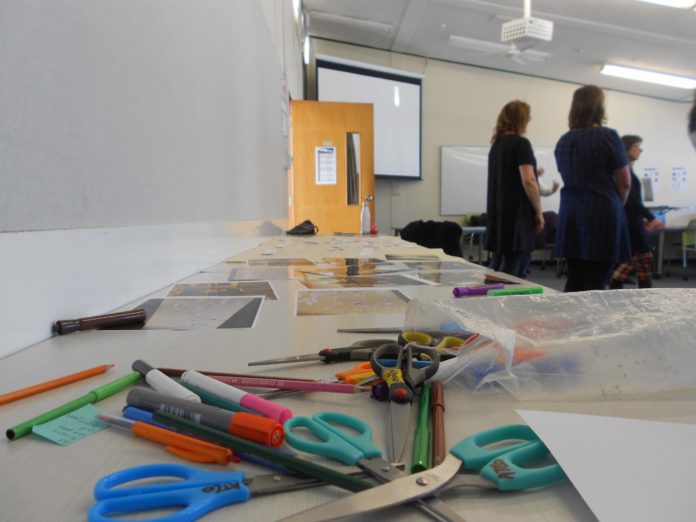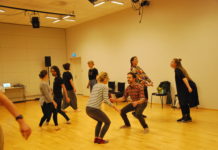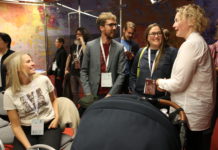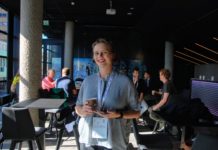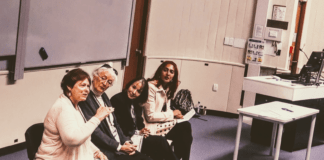One of the great privileges of documenting conferences such as the International Drama in Education Research Institute is being able to partake in diverse practical workshop sessions. On Day 2 of the 7-day event, I had the pleasure of sitting in on two wonderful workshops and jotted down some brief diary reflections on each.
Workshop 1 – Push/Pull: Dramatising the global migration crisis with smartphone web apps
In the first workshop, Paul Sutton and Max Dean explored an innovative intersection between digital technologies and Applied Theatre practices, sharing their digital platform Prospero with us. Prospero is a technology-driven system created by C&T, a UK based Applied Theatre company that blurs the lines between drama, learning, and digital technologies. In this workshop, Sutton and Dean demonstrated how Prospero is utilised as a digital tool for C&T’s Push/Pull Project, the heart of which is the global migration crisis. Utilising the Prospero system, Push/Pull works as a process encoded web app, which aims to “shape global literate citizens” and break down barriers by sharing diverse stories of migration. Discussing the vital role mobile phones play within 21st Century migration, they stressed the applicability of digital platforms both to this project specifically and to other Applied Theatre practices generally.
My (albeit limited) understanding of the Push/Pull web app is that it guides a step by step process for teachers and/or artists to enable them to run the Push/Pull project in their local areas. It digitally breaks down the process of how to facilitate a workshop, meaning the facilitator does not need to be an expert or even know each step in advance: the facilitator can experience the process alongside their participants. “It facilities, drives and enables the creation of drama based digital narratives that track the real-life journeys of migrants”(taken from abstract).
The following photos and instructions of two activities presented by Sutton and Dean during the workshop aim to provide a brief explanation of how the Push/Pull web app could be used in practice. However, to witness the full potential of such activities, you can visit the following sites to learn more:
www.pushpull.tech
www.prospero.digital
Activity 1

- The participants were given mobile phones with the Push/Pull web app already installed. They were asked to scan a QR code in order to link their phones with the Push/Pull site.

- On the Push/Pull site, which was mirrored on the projector for everyone to see, the volunteers were asked to assign themselves a role displayed on the app on their phones. Each volunteer wrote their names, assigning themselves to either Actor 1, 2, or 3.
- Actor 1 was instructed to read the script displayed on their phone. When Actor 1 finished reading their line they pushed a button, which ‘passed’ the script to Actor 2’s screen and so forth.

- While the Actors read the script from their phone, the site (being projected onto the screen) displayed various different videos, audio, and photographs around the themes of the script, supporting the development of the narrative.
Activity 2
- On the home page of Push/Pull we watched a short video explaining the Push/Pull method. We were then asked to pick either ‘Push’ or ‘Pull’. After choosing ‘Pull’, the site lead us to watch a simple video explaining the next activity and demonstrating an exemplar.
- The volunteers’ phones instructed them on their next step – to get into groups of 4.
- The next activity was for one volunteer in the group to tell a 30-second personal story of what ‘pulled’ them to the IDIERI 9 event. After a quick rehearsal and group discussion, this story was filmed.

- The groups joined together and showed each other their films on their devices.


After this exciting start, the workshop continued with further interactive exercises so, as I needed to head off early to document the second half of another workshop, I had a serious feeling of missing out on some fascinating experiences and discussions.
Workshop 2 – ‘Dance by the fire, or worship the ashes?’
Though it was immediately apparent that Ginnie Thorner’s workshop was vastly different in delivery and method to Sutton and Dean’s, having seen only the second half of the session, I felt similarly upset that I was missing out on some excellent workshop practice. It is only the 2nd day of IDIERI 9 and the multiplicity of Applied Theatre practices and research that has already been presented here is incredibly exciting.

When I entered the room, everyone was standing in a circle. I watched pairs move together one at a time into the centre, create a shape, and move out again. Although I might not have known exactly what was going on, it remained beautiful to watch the silent communication and improvised movement between not only the pairs but the whole group.



I slowly began to piece together the story through the participants’ discussion and Thorner’s instructions. Today’s hour and a half devised drama and movement workshop represented a ‘compressed’ series of workshops that Thorner had created for Y4-8 students in response to the earthquake in her hometown, Christchurch. Through the fictional context of a village dealing with disaster in a storybook, the students explored and questioned what the village must decide to do; were they to rebuild or to move on?
It transpired, that the movement I had witnessed when I arrived in the workshop had been the participants had been creating a ritualistic village dance that the fictional ‘villagers’ danced on a daily basis. For me, this movement with music had a simple elegance and communicated a connectedness of the participants who represented a fictional community forged just 45 minutes prior.





After discussion, Thorner asked the participants to create rubble in the centre of the circle, to represent the ruin of their village. Thorner asked the ‘villagers’ to take shape of how they would respond to seeing the ruin of their village for the first time, and what they should do now.


“We should clear the rubble and do our daily dance”
“We should dance among the rubble”
“I think we should leave the rubble as a reminder/memory of the pain”
“We should leave, there’s nothing we can do now”
The story today finished as the villagers danced their daily dance once more. However, this time those that decided to leave stepped out of the circle, sometimes even leaving their partner dancing by themselves.




